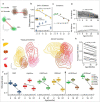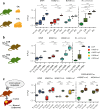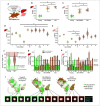This is a preprint.
Imaging-based chromatin and epigenetic age, ImAge, quantitates aging and rejuvenation
- PMID: 37986947
- PMCID: PMC10659560
- DOI: 10.21203/rs.3.rs-3479973/v1
Imaging-based chromatin and epigenetic age, ImAge, quantitates aging and rejuvenation
Update in
-
ImAge quantitates aging and rejuvenation.Nat Aging. 2024 Sep;4(9):1308-1327. doi: 10.1038/s43587-024-00685-1. Epub 2024 Aug 29. Nat Aging. 2024. PMID: 39210148
Abstract
Biomarkers of biological age that predict the risk of disease and expected lifespan better than chronological age are key to efficient and cost-effective healthcare1-3. To advance a personalized approach to healthcare, such biomarkers must reliably and accurately capture individual biology, predict biological age, and provide scalable and cost-effective measurements. We developed a novel approach - image-based chromatin and epigenetic age (ImAge) that captures intrinsic progressions of biological age, which readily emerge as principal changes in the spatial organization of chromatin and epigenetic marks in single nuclei without regression on chronological age. ImAge captured the expected acceleration or deceleration of biological age in mice treated with chemotherapy or following a caloric restriction regimen, respectively. ImAge from chronologically identical mice inversely correlated with their locomotor activity (greater activity for younger ImAge), consistent with the widely accepted role of locomotion as an aging biomarker across species. Finally, we demonstrated that ImAge is reduced following transient expression of OSKM cassette in the liver and skeletal muscles and reveals heterogeneity of in vivo reprogramming. We propose that ImAge represents the first-in-class imaging-based biomarker of aging with single-cell resolution.
Conflict of interest statement
COMPETING FINANCIAL INTERESTS The authors declare no competing financial interests.
Figures






References
-
- Baker G. T. & Sprott R. L. Biomarkers of aging. Experimental Gerontology 23, 223–239 (1988). - PubMed
-
- LaPierre T. A. & Hughes M. E. Population aging in Canada and the United States. in International handbook of population aging 191–230 (Springer, 2009).
-
- Control, Centers for Disease & Prevention. Trends in aging--United States and worldwide. MMWR. Morbidity and mortality weekly report 52, 101–106 (2003). - PubMed
Publication types
Grants and funding
LinkOut - more resources
Full Text Sources

